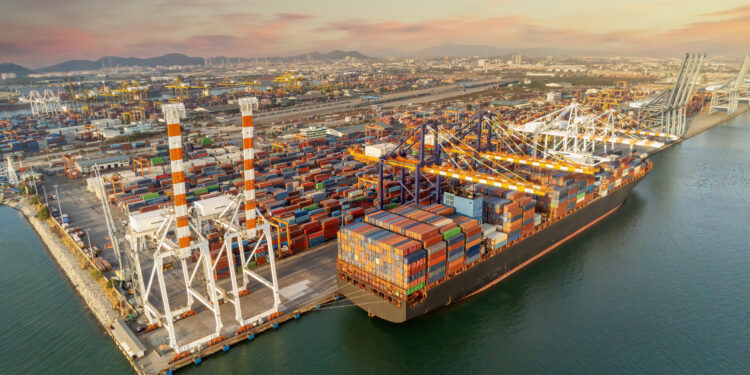ZIM Integrated Shipping Services Ltd. (NYSE:ZIM) is one of the world’s leading global container liner shipping companies, with a history that spans over 75 years of maritime innovation, strategic expansion, and adaptive resilience. Headquartered in Haifa, Israel, ZIM operates as a global carrier providing sea freight and logistics solutions across major international trade routes, serving more than 90 countries through a network of over 150 weekly shipping lines. Established in 1945, ZIM began as the shipping arm of Israel’s early trade network and has since evolved into a multinational enterprise that plays a pivotal role in the movement of goods and raw materials worldwide. The company’s transformation from a regional cargo operator into a digitally advanced shipping leader represents one of the most remarkable modernization stories in the global logistics industry.
ZIM’s business model is centered on delivering efficient, reliable, and technology-driven containerized shipping services. The company operates a diversified fleet that includes both owned and chartered vessels, with capacities ranging from feeder ships to ultra-large container carriers. Its asset-light strategy—focusing primarily on long-term vessel charters rather than heavy ownership—allows ZIM to maintain operational flexibility and reduce capital intensity, an approach that sets it apart from traditional shipping giants. This model has enabled ZIM to scale rapidly in response to market shifts while maintaining a competitive cost structure. In 2021 and 2022, this strategy proved particularly advantageous as global trade rebounded from the pandemic and freight rates surged to record levels, catapulting ZIM into one of the most profitable periods in its corporate history.
The company’s extensive global coverage is organized around major trade lanes, including the Transpacific, Transatlantic, Intra-Asia, and Latin America routes, connecting key ports in Asia, North America, Europe, and the Mediterranean. ZIM has consistently invested in digital transformation and customer-centric innovation, introducing cutting-edge platforms that enable real-time tracking, predictive logistics, and paperless trade solutions. These technological investments have allowed ZIM to enhance visibility and efficiency throughout its global supply chain, catering to modern customers demanding faster, smarter, and more transparent shipping experiences. Its focus on digital shipping platforms and e-commerce integration has made ZIM a recognized technology leader in the maritime industry—an achievement underscored by its partnerships with logistics tech firms and data analytics providers.
ZIM’s fleet modernization efforts are also central to its long-term strategy. The company has signed multi-year charter agreements for advanced liquefied natural gas (LNG)-powered vessels, which are expected to significantly reduce carbon emissions and fuel costs. This environmental commitment aligns with the International Maritime Organization’s (IMO) decarbonization goals and positions ZIM as a forward-looking carrier ready for the next phase of sustainable global trade. The company’s adoption of alternative fuels and advanced energy-efficient technologies demonstrates its dedication to combining profitability with environmental responsibility, a growing priority in the shipping and logistics sectors.
ARTICLE HIGHLIGHT: Tony Zhou of Waton Financial (WTF) Unveils “InfoMan” AI Agent at New Fortune Annual Meeting in Guangzhou.
Financially, ZIM has experienced a cycle of record highs and challenging corrections—reflective of the volatility inherent in global shipping markets. During the pandemic-era shipping boom, the company posted unprecedented profits, surpassing billions in net income and becoming one of the most lucrative shipping firms in the world. It used this windfall to strengthen its balance sheet, pay down debt, and distribute significant dividends to shareholders. However, as global freight rates normalized and demand slowed, ZIM entered a period of recalibration, focusing on operational efficiency, cost management, and network optimization. The company continues to emphasize disciplined capital allocation, strategic partnerships, and digital integration to maintain competitiveness even amid market downturns.
ZIM’s long-standing reputation is built on a foundation of reliability, adaptability, and customer service. With over seven decades of experience navigating the world’s most complex maritime routes, the company has cultivated deep relationships with global manufacturers, retailers, freight forwarders, and supply chain partners. Its agility in responding to market fluctuations and geopolitical shifts has allowed it to remain profitable through multiple global trade cycles. Today, ZIM stands at a strategic crossroads—balancing the pursuit of sustainable growth with the need to navigate structural challenges in the shipping industry, including overcapacity, volatile freight pricing, and rising regulatory standards.
As one of the few publicly traded shipping companies on the New York Stock Exchange, ZIM offers investors direct exposure to the container shipping industry’s global performance. Its emphasis on digital transformation, sustainability, and capital efficiency continues to distinguish it within a historically asset-heavy industry. Whether through its LNG fleet expansion, AI-driven logistics systems, or commitment to operational transparency, ZIM Integrated Shipping Services remains a symbol of the modern maritime era—a company that merges the heritage of global trade with the innovation of tomorrow’s logistics technology.
Earnings Pressure, Slowing Trade, and the Risk of a Hard Landing
ZIM Integrated Shipping Services Ltd. (NYSE: ZIM) is once again in the spotlight as Wall Street braces for a significant year-over-year decline in both earnings and revenue ahead of its Q3 2025 earnings report scheduled for November 20. Once celebrated for its pandemic-era profitability and massive dividend payouts, ZIM is now navigating a harsh post-boom environment defined by weakening freight rates, collapsing demand, and rising operational costs. The market’s consensus paints a sobering picture: earnings per share are projected at $1.67, reflecting an 82.1% decline year-over-year, while revenue expectations stand at $1.93 billion, down 30.1% from the same period in 2024. These numbers highlight the deep cyclical headwinds now weighing on the container shipping sector — and suggest that ZIM’s stellar performance may have peaked.

CHECK THIS OUT: Above Food (ABVE) to Issue 1.1 Billion New Shares in Merger and Perpetua Resources (PPTA) Soars 171% as U.S. Approves $1.3B Gold-Antimony Mine.
From Pandemic Hero to Post-Boom Casualty
ZIM’s dramatic rise during 2020–2022 was fueled by historically high freight rates amid global supply chain disruptions. The company capitalized on record shipping demand and supply shortages, posting billions in profits and distributing some of the highest dividends on Wall Street. However, as global trade normalized and freight rates reverted to pre-pandemic levels, ZIM’s fortunes shifted sharply. According to industry trackers like Drewry’s World Container Index, average global shipping rates in 2025 are over 70% lower than the highs seen in 2022, cutting deeply into ZIM’s margins.
ZIM’s reliance on the Asia–U.S. and Asia–Europe routes makes it particularly vulnerable to declining spot rates, which have fallen sharply due to overcapacity and weakened demand in consumer goods. As a result, the company’s once-explosive profitability has reversed into a fight for survival in a hyper-competitive environment. While ZIM remains one of the most digitally advanced container carriers globally, with a modernized fleet and strong partnerships, its exposure to macroeconomic volatility leaves investors with limited visibility into future earnings stability.
Earnings Consensus and Bearish Momentum
The Zacks Consensus Estimate for ZIM’s upcoming quarter underscores the bearish sentiment among analysts. Despite no major revisions over the past 30 days, the company’s Earnings ESP (Expected Surprise Prediction) stands at -24.32%, signaling that the most accurate analyst forecasts are now below the broader consensus. This metric reflects declining confidence in ZIM’s near-term profitability and suggests that analysts have turned more conservative as freight and charter markets weaken further.
Adding to the concern, ZIM’s historical earnings performance offers little reassurance. In the previous quarter, analysts projected earnings of $1.50 per share, but the company reported just $0.19, missing estimates by a staggering -87.33%. Over the last four quarters, ZIM has managed to beat consensus estimates only three times, with each beat driven by temporary rate surges or fuel cost fluctuations rather than sustainable operational gains. The company currently holds a Zacks Rank #3 (Hold), a neutral position that further reinforces the uncertainty surrounding its ability to outperform market expectations.
Revenue Compression and Global Trade Headwinds
The expected 30% year-over-year decline in revenue for Q3 2025 highlights the depth of the industry’s downturn. Global trade growth has slowed significantly, weighed down by soft demand from Europe and the United States, rising energy prices, and disruptions in key shipping corridors such as the Red Sea and Suez Canal. ZIM’s exposure to these trade lanes means it is directly impacted by rerouting costs, insurance premiums, and port delays, all of which have inflated operational expenses.
At the same time, the shipping industry is facing a capacity glut as carriers that ordered new megaships during the pandemic are now flooding the market. This excess capacity is driving rates lower even as costs remain high, squeezing margins across the board. ZIM’s chartered fleet model, which relies heavily on leased vessels rather than owned assets, further compounds the problem, as fixed charter costs must be paid regardless of utilization rates. This structure provided flexibility during boom times but has become a liability in a downturn.
Rising Cost Pressures and Operational Vulnerabilities
One of ZIM’s most pressing challenges is managing rising operational costs amid falling revenues. The company faces higher bunker fuel prices, increased port fees, and elevated insurance costs due to geopolitical instability in key shipping routes. Moreover, as the industry transitions toward decarbonization, ZIM must invest heavily in compliance and emissions-reduction technologies to meet international maritime standards. These investments will likely strain its balance sheet and delay any near-term margin recovery.
Adding to this, the company’s exposure to volatile foreign exchange markets and inflationary pressures has eroded profitability. While ZIM maintains a strong cash position relative to its peers, its debt obligations and lease commitments leave limited room for flexibility should the downturn extend into 2026.
Investor Sentiment and Stock Price Volatility
ZIM’s share price performance in 2025 reflects investor skepticism about the company’s ability to sustain earnings in a weakening freight environment. The stock, which once traded above $80 per share in early 2022, has since fallen sharply as profits evaporated. Analysts remain divided on whether ZIM can rebound once global trade stabilizes, but near-term catalysts appear limited. The company’s high dividend payouts during the boom years have also raised concerns about capital allocation, as management may need to prioritize debt repayment and operational reinvestment over shareholder returns.
Market participants now view ZIM less as a high-yield value play and more as a speculative bet on the timing of the next freight-rate upcycle. Until that rebound materializes, investors are likely to face continued volatility, particularly if upcoming earnings disappoint expectations once again.
Looking Ahead: The Road to Recovery Looks Long
While ZIM remains a significant player in global shipping with a solid brand and operational scale, the short-term outlook is undeniably bearish. The combination of falling freight rates, rising costs, and shrinking profit margins makes it difficult for the company to maintain consistent earnings. The upcoming Q3 2025 earnings report could serve as a critical inflection point: a meaningful miss could trigger another wave of downgrades, while even a modest beat may not be enough to offset structural headwinds.
For now, analysts expect earnings contraction of over 80% year-over-year and a sustained revenue decline into 2026 unless trade volumes recover. Without a sharp rebound in global demand or significant capacity rationalization across the industry, ZIM Integrated Shipping Services faces an uphill battle to restore profitability and investor confidence.
READ ALSO: NioCorp (NB)’s $1.14B Elk Creek Project Set to Transform U.S. Critical Minerals Supply and Endeavour (EXK) Poised to Double Output With Kolpa and Terronera Expansion.






